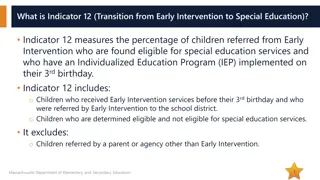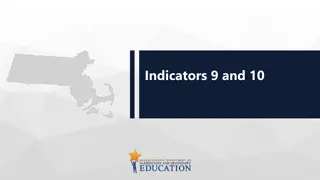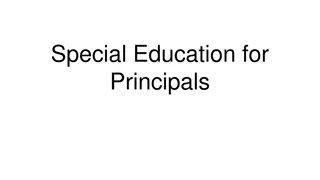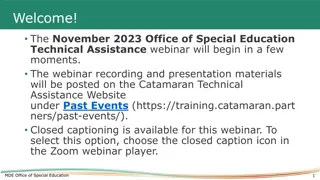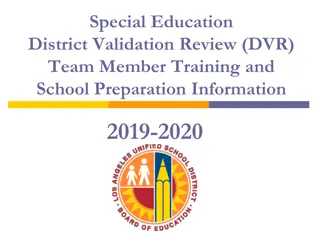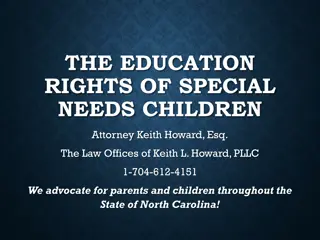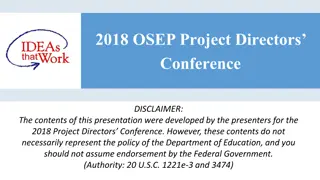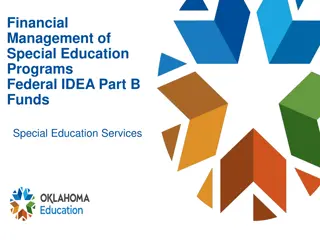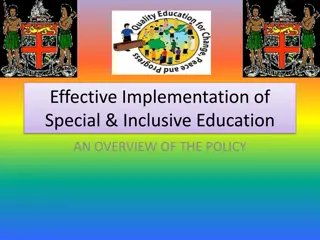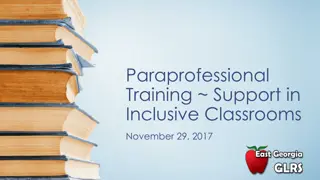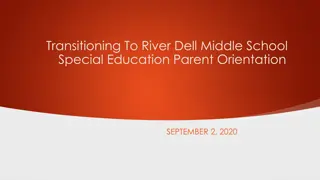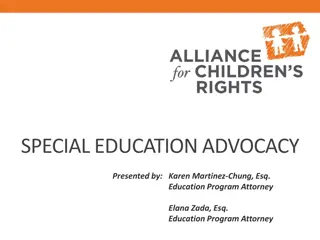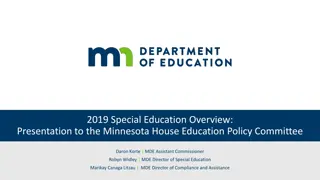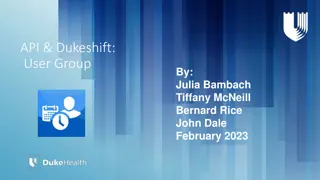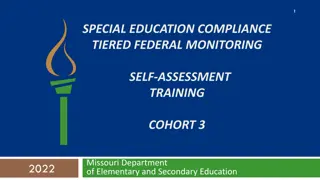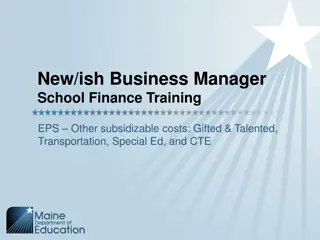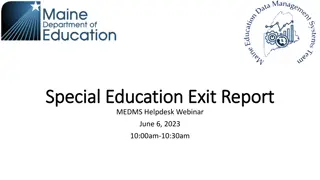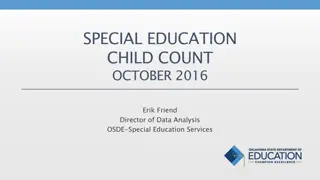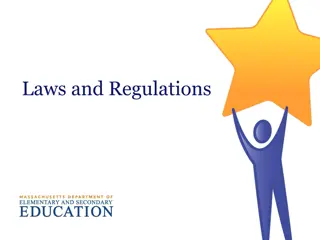Understanding the Special Education Process
Special education involves a multi-step process that includes determining eligibility, individualized education programs, referrals, evaluations, and more. The process aims to meet the unique needs of students with disabilities through specially designed instruction and services provided at no cost to parents. Committees such as the Committee on Preschool Special Education and the Committee on Special Education play crucial roles in evaluating students and recommending appropriate educational programs and services.
Uploaded on Oct 09, 2024 | 0 Views
Download Presentation

Please find below an Image/Link to download the presentation.
The content on the website is provided AS IS for your information and personal use only. It may not be sold, licensed, or shared on other websites without obtaining consent from the author. Download presentation by click this link. If you encounter any issues during the download, it is possible that the publisher has removed the file from their server.
E N D
Presentation Transcript
SPECIAL EDUCATION WHAT ARE THE STEPS IN THE SPECIAL EDUCATION PROCESS? Office of Pupil Services Sherrisse Young, Director of Pupil Services January 2022
The Process You will learn about What is Special Education Who makes up the Committee Committee on Preschool Special Education Determining Eligibility Committee on Special Education 13 Disabilities Why are referrals made to the CSE Individual Education Program Who can refer a student Continuum of Services The Referral Annual Review/Reevaluation The Request for Referral Transfer Students Prior Written Notice and Consent for Initial Section 504 Evaluation Difference between Section 504 and IEP Individual Evaluation Process
What.. What is Special Education? Special Education (as per Part 200 regulations) Individual student needs shall be determined by the means Committee on Special Education. specially designed individualized or Consideration is given to the present levels of performance group instruction or and expected learning outcomes of the student. Special services or This information provides the data for developing Programs and measurable annual goals, determining appropriate Special transportation educational services and programs and overall development Provided at no cost to the parent, to meet the of an IEP (Individualized Education Program). unique needs of students with disabilities Such instruction includes specially designed Areas considered: Academic achievement, functional instruction in physical education, including performance and learning, social development, physical adapted physical education development, and management needs.
Committee on Preschool Special Education Parents who suspect their child (ages 3-5) has a disability due to concerns with: Developmental Milestones (Speech/Language Skills, Motor Skills, Adaptive Behavior Skills) Early Intervention (EI to CPSE Transition) Referral Process Evaluation Process Conducted by county approved evaluation sites Parent chooses the evaluator Eligibility Determination One classification Preschooler with a Disability IEP Implementation Related Service Providers/Programs - County approved
The Committee on Special Education A multi-disciplinary team established in accordance with the provisions of section 4402 of the Education Law Is responsible for evaluating all school-age students (ages 5-21) suspected of having a disability, identifying a disability or determining that no disability exists, and recommending placement and type of special education programs and/or services within sixty (60) days of the date of receipt of consent for evaluation Recommending programs/services in the least restrictive environment in which a student is successful Referrals can be made at any time during the 12-month year
Why would a student be referred to the Committee on Special Education? A student is suspected of having a disability The student has not made adequate progress (educationally and/or behaviorally) after an appropriate period of time when provided instruction within a multi-tiered problem-solving approach that utilizes systematically applied strategies and targeted instruction (Academic Intervention Services, Response to Intervention, Multi-Tiered System of Supports, and Educationally Related Support Services)
Who can refer a student? A referral may be made by : A student s parent/guardian including an individual who is acting in the place of a birth or adoptive parent such as a grandparent, stepparent, or other relative with whom the child resides and has legal custody of the child; or A designee of the school district in which the student resides; The commissioner; and/or A designee of an education program affiliated with a childcare institution with Committee on Special Education responsibility The following people can make a written request that the school district refer the student for an initial evaluation: Professional staff member of a public agency with responsibility for the welfare, health, or education of children; or Professional staff member of the school district in which the student resides or the public or private school the student legally attends; A student over eighteen years of age or emancipated can refer him/herself; Judicial officer; Licensed physician
The Referral Referrals: Must be made in writing Must state the reasons for the referral Include any test results, records, or reports upon which the referral is based Describe in writing the efforts made by the school and parents/guardians to resolve the difficulties leading to the referral Include interventions services, programs, or instructional methodologies used to remediate the students school performance prior to the referral Referrals can be given directly to the Committee on Special Education Chairperson, the building principal, or to the building School Psychologist The chairperson must immediately notify the parent of the referral, provide the Procedural Safeguards Notice, the Parent Guide to Special Education, prior written notice to conduct an initial evaluation including the consent to evaluate.
The Request for Referral Requests for a referral Must be in writing Must state the reasons for the referral and test results, records, or reports (except if submitted by the student or judicial officer) Intervention services, programs, or methodologies used to remediate the student s performance prior to the referral, or state reasons why no such attempts were made Describe the extent of prior parent contact Upon receiving a request for a referral, the school district must within 10 school days, either: Request parent consent to initiate evaluation; or Provide the parent with a copy of the request for referral; and Inform the parent of his/her right to refer the child for an initial evaluation; and Offer the parent the opportunity to meet to discuss the request for referral and, as appropriate, the availability of appropriate general education support services
Prior Written Notice and Consent for Initial Evaluation Consent Prior Written Notice is a written statement that informs and provides the parent/guardian of a student with reasonable time before the school district proposes to or refuses to initiate or change identification, evaluation, or educational placement of the student or the provision of a free appropriate public education to the student Information must be in the native language or other mode of communication Parent/Guardian understands and agrees in writing to the activity for which the consent is sought (referral to special education and evaluations to be conducted) Parent/Guardian is made aware that their consent is voluntary on the part of the parent and may be revoked at any time Parent/Guardian understands that revoking consent is not retroactive
Individual Evaluation Process After the parent has received and signed the prior written notice with consent to evaluate Evaluations must be completed within 60 calendar days of receipt of consent. Evaluator must keep written documentation of all attempts to evaluate the student. Must be at no cost to the parent Must include relevant information related to allowing the student to participate and progress in the general education curriculum Include information presented by the parent Must include at least: A social history An individual psychological evaluation An observation of the student in the student s learning environment A physical examination Other appropriate assessment or evaluations including an educational evaluation, speech/language evaluation, occupational therapy evaluation, physical therapy evaluation, functional behavior assessment, or psychiatric evaluation as it pertains to the suspected disability.
Who is on the Committee for Special Education The Committee shall include but not be limited to: The parents/guardians At least one regular education teacher of the student At least one special education teacher/provider of the student A school psychologist A CSE Chairperson A school physician, if specifically requested in writing by the parent of the student or by a member of the school at least 72 hours prior to the meeting. If specifically requested, an additional parent member of a student with a disability residing in the school district, provided that the additional parent member may be the parent of a student who has been declassified within a period not to exceed five years or the parent of a student who has graduated within a period not to exceed five years Other persons having knowledge or special expertise regarding the student, including related service personnel as appropriate.
Determining Eligibility Interpreting evaluation data Based on the evaluation results the CSE determines if the student meets criteria for one of the 13 disabilities and if so, what types of services, accommodations and programs that may be required. Part 200 13 classifications A student shall not be determined eligible for special education if the determinant factor is: Lack of appropriate instruction in reading, including explicit and systematic instruction in phonemic awareness, phonics, vocabulary development, reading fluency (including oral reading skills) and reading comprehension strategies; Lack of appropriate instruction in math; or Limited English proficiency
13 Disability Classifications Autism Deafness Deafness-Blindness Emotional Disturbance Hearing Impairment Intellectual Disability Learning Disability Multiple Disabilities Orthopedic Impairment Other Health Impaired Speech or Language Impairment Traumatic Brain Injury Visual Impairment
Individualized Education Program If a student is determined eligible to receive special education services by the Committee, the committee develops and implements an appropriate Individualized Education Program based on the evaluation results and classroom performance. The plan is designed to meet the individual needs of the student and provide programming and services within the least restrictive environment (LRE). LRE means that the placement of students with disabilities in special classes, separate schools or other removal from the general education environment occurs only when the nature and severity of the disability is such that even with the use of supplementary aides and services, education cannot be satisfactorily achieved. Education should be provided to the maximum extent appropriate within the general education setting Programs/services should be as close as possible to the student s home
Continuum of Special Education Services Related Services Resource Room Consultant Teacher Integrated Co-Teaching Special Education Classes (Special Class 15:1, Special Class 8:1:1,etc.) Home and hospital instruction
Annual Review/Reevaluation The Committee on Special Education reviews the IEP at least once annually A parent or the school team can request a meeting sooner to review the IEP A child is reevaluated at minimum every three years Parents may request and receive an evaluation sooner than three years
Students who move into Baldwin with an IEP from their prior School District Baldwin is responsible for: Providing the student with a comparable program/services (for example, if a student moves into Baldwin and is currently placed in a residential program, Baldwin will need to implement the same program upon completion of the student's registration) Steps Taken Registration form asks if the student has an IEP or 504 Accommodation Plan. Parent signs a release of records so Baldwin can obtain special education records from the prior school district. The IEP (and evaluations if provided) from the prior school district is reviewed. A comparable program/services is reviewed with the parent. The parent/guardian either signs that they agree with the comparable program and waive their right to a CSE meeting immediately or indicates that they want a CSE meeting immediately to create an IEP. School team implements the comparable IEP (if agreed) and takes time to get to know the student's current academic levels. A CSE meeting is scheduled within 30 days to review the student's progress since transitioning to Baldwin. A Baldwin IEP is created.
Section 504 Federal Civil Rights Act Ensures nondiscrimination based on disability in federally funded programs Physical or mental impairment which substantially limits one or more major life activities A Section 504 Accommodation Plan provides accommodations and modifications
The Difference between an IEP and Section 504 IEP 504 Special Education Individual with Disabilities Act Civil Rights- Rehabilitation Act of 1973 (IDEA) Has a disability that: Has a disability that significantly impacts a major life Meets criteria under IDEA function Significantly impact educational performance and Requires specialized instruction/services Provides for specialized education services, Accommodations and modifications accommodations, related services IEP offered until the student receives a diploma or age No age limit with a 504 21



